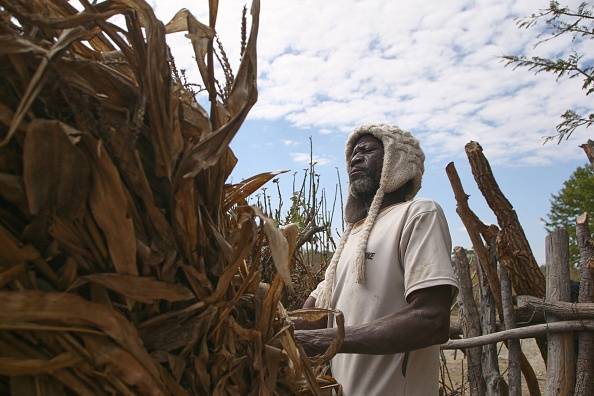
Farmer Takeshure Chimbu combs through dried stover salvaged from a failed maize harvest in Muzi on July 2, 2024. Chimbu wants to save the stover to feed his livestock, who have little pasture this year due to the El Niño-induced drought. (NJIKIZANA/AFP via Getty Images)
All that remains of the Kapotesa Dam, which once provided vital water for crops and livestock in this remote part of Zimbabwe, is a sand bed and mud piles.
Nearby, farmer Georgina Kwenwere walks among corn stalks scorched by the drought that has hit her home country and left millions in need of food aid.
“I worked so hard, spent all my savings to buy seeds, and yet I didn't get a single harvest,” the 54-year-old said, shaking her head in despair. “Not even a single cob.”
The Kapotesa dam dried up in May, Kwenwere said. “God only knows how we will survive until next year's harvest,” she said.
When the rains are good, Kwenwere and her husband can use water from a dam in the northeastern district of Muzi to grow vegetables that can feed themselves and their six children, and sell the surplus for cash to buy livestock and pay school fees.
Now, along with other villagers, Kwenwere has to walk five kilometres every day to a business centre in the small town of Kotwa to find temporary work to buy food.
On a good day, he can earn about $3, but on a bad day, he ends up walking the long way home to his village of Mahuta with nothing.
Like most villagers in the district of about 164,000 people, her family has reduced their diet to two meals a day.
“Most of us have no food at home,” said Takesule Chimbu, 58, also from Mahuta. “Without water, everything is ruined,” he told AFP.
Muzi district medical officer Kudzai Madamombe said there had been an increase of about 20 percent in malnutrition cases over the past three months.
“Food, especially, is quite expensive in this region as it is prone to drought,” he said, calling for government assistance.
Nutritious porridge
Faced with a sharp rise in malnutrition, health experts in Muzi have come up with a nutritious porridge called “Mawolesa”, which means “the best” in the local Shona language.
They are made from inexpensive, locally sourced ingredients, including eggs, sugar cane and baobab fruit donated by villagers.
Madamombe said the porridge was designed to meet basic nutritional needs with a combination of carbohydrates, protein, fruits and vegetables.
“This goes a long way towards curbing malnutrition with as little investment as possible and ensuring that every child in every household receives at least four basic food groups at least once a week,” he said.
Zimbabwe and neighbouring Malawi and Zambia are among the southern African countries hardest hit by malnutrition caused by a severe drought that experts say has been exacerbated by the El Niño weather phenomenon.
In May, President Emmerson Mnangagwa declared a state of disaster, saying Zimbabwe needed at least $2 billion to deal with the drought.
The United Nations said in May that at least 7.6 million people – nearly half the population – were in need of aid, with children under five and pregnant and breastfeeding women most affected.
“The harvest is not coming up as expected,” UNICEF Zimbabwe chief communications officer Eve Willemoth told AFP. “Most people are living in very dire conditions, with no access to water or food.”
In early June, the United Nations launched an appeal for $429 million in drought aid for Zimbabwe.
“So far, apart from our internal resources and those from the UN treasury, we have not yet received any donations,” Willemoth said.
© Agence France-Presse

